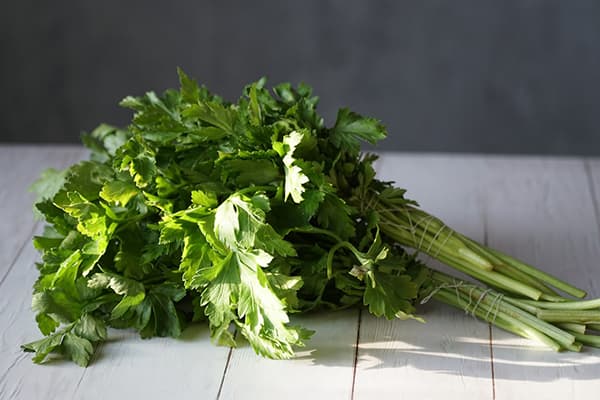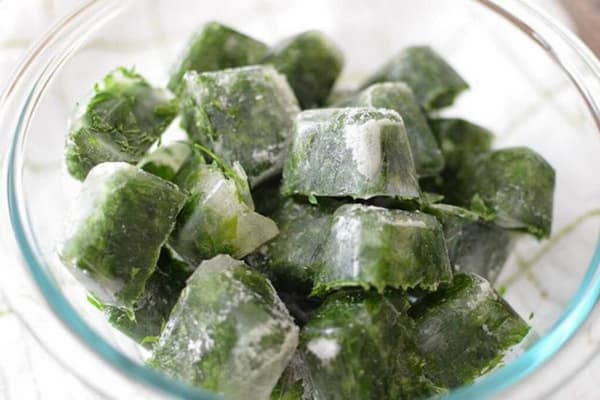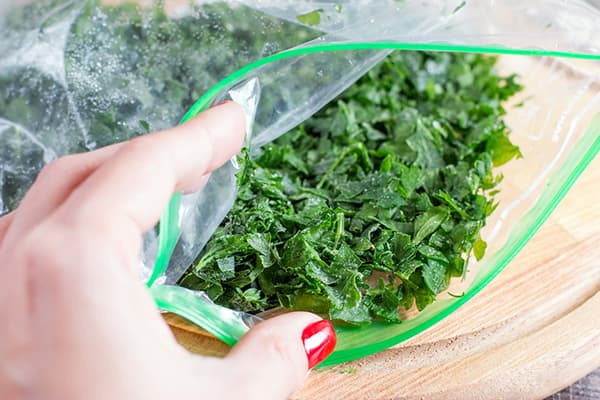How to freeze parsley for the winter: 3 ways
In order not to buy greens at inadequate prices during the cold season, it is better to set aside a little time in the summer and freeze the parsley for the winter in the freezer. Freezing allows you to preserve the beneficial properties of the plant, its aroma and taste, so you can safely add frozen greens to first or second courses.

Method No. 1 - freezing whole bunches
This method is the simplest of all existing ones. Freezing greens requires minimal effort and time. It needs to be prepared for freezing - rinse thoroughly, remove the wilted leaves. To avoid pieces of ice when defrosting, the parsley should be slightly dried: put on a dry waffle towel and leave for 10–20 minutes until the water is completely drained.
You can trim the stems further if they are not normally used for cooking. Then divide into small bunches, which will be used as a single portion for cooking. Pack into disposable bags and place in the freezer.
Advantage of the method:
- it doesn't take much time or effort.
Flaws:
- greens are defrosted in whole bunches, so they will have to be cut additionally;
- Packing in bags is required.
Method number 2 - freezing in the form of ice cubes
This method requires much more time than the previous one. But as a result, it will be enough to get a ready-made ice cube with parsley and add it to the dish. There is no need to cut anything additional.
To properly freeze greens, you must first prepare them:
- To begin with, wash it thoroughly. You don’t have to dry it, because in the future the parsley will be filled with water.
- After washing, finely chop and tightly fill ice cube trays with already chopped herbs.
- Then add water and place in the freezer.
Some housewives experiment and use melted butter rather than water as a filling. Sometimes it is additionally salted so that the parsley acquires a special taste. But you need to understand that this freezing option is not suitable for all dishes. For example, butter is not appropriate in some vegetable salads.
Advantages:
- freezing in convenient portions;
- no need for bags or packaging;
- You can experiment and freeze with butter.
Flaws:
- preliminary shredding is necessary;
- you will need a lot of ice trays;
- if you need to add greens to the salad, you will have to wait until the ice melts;
- The process of putting parsley into molds is not very convenient and takes a lot of time.
Method number 3 - freezing in crushed form
Housewives use this freezing option most often:
- Before freezing parsley, as in all previous cases, it must be thoroughly washed and all wilted leaves removed.
- If the stems are not used for cooking, it is worth trimming them.
- Next you need to dry the greens. You should not leave it for a long time without refrigeration, as it quickly loses its original appearance, valuable taste and nutritional properties, and fades. It is enough to wait until the water has completely drained.
- Then you need to chop the greens and package them in bags. In this case, it is not necessary to distribute the parsley into single portions.
You can compact a whole disposable bag, and when you need a portion of greens, use a knife - the parsley will be easily separated from the total mass if it has been dried before freezing.
Advantages:
- when you need frozen greens, you can always separate the desired portion rather than defrosting a whole bunch;
- Compared to freezing in cubes, there is no need to wait for the ice to melt and excess liquid to drain if the greens are needed for a salad.
Flaws:
- Preliminary preparation of greens is necessary: washing, fine chopping.
Of course, the best parsley is the one that is just picked from the garden. But when this is not possible, freezing is the best option, especially since prices for greens in the supermarket in winter are quite high.

